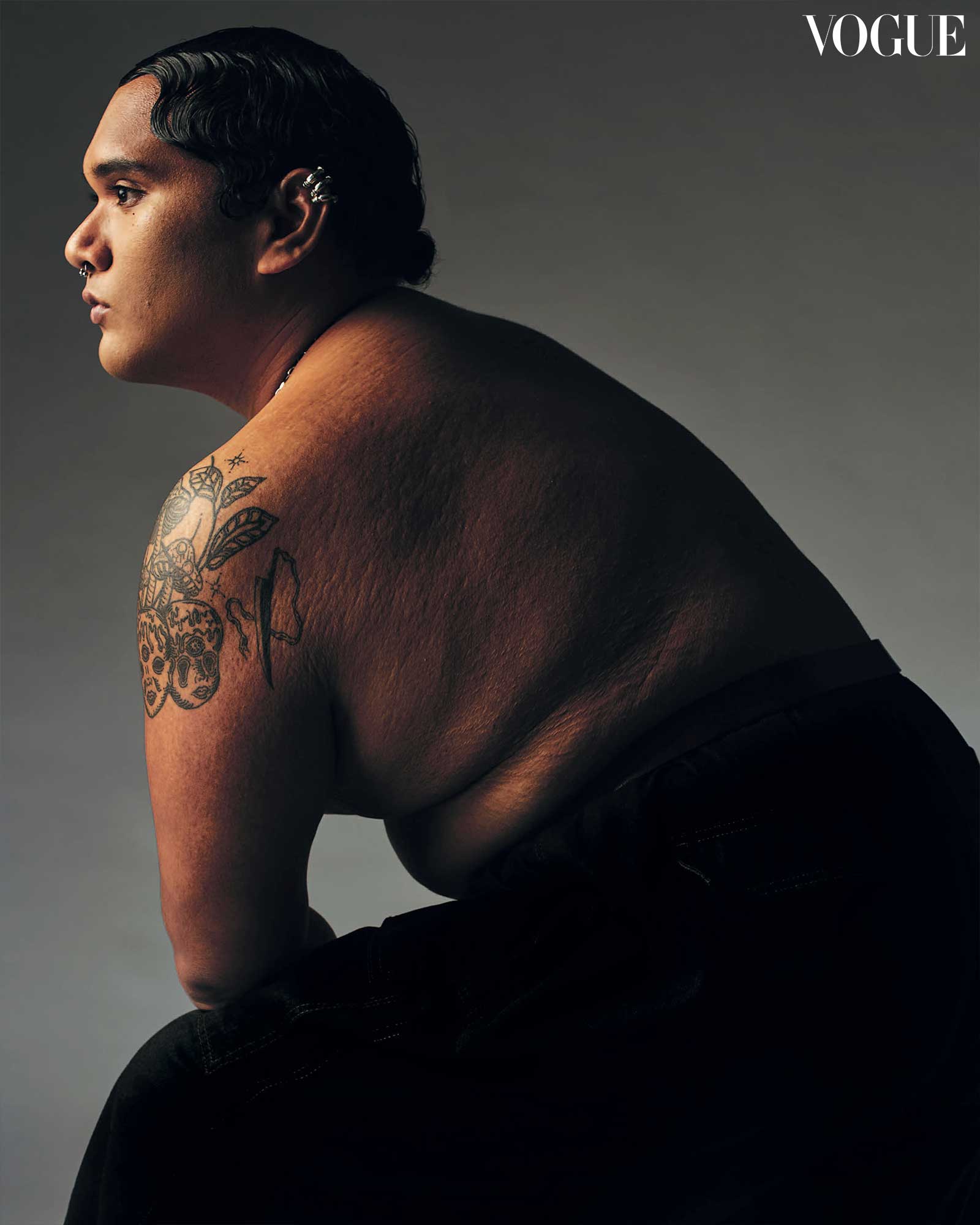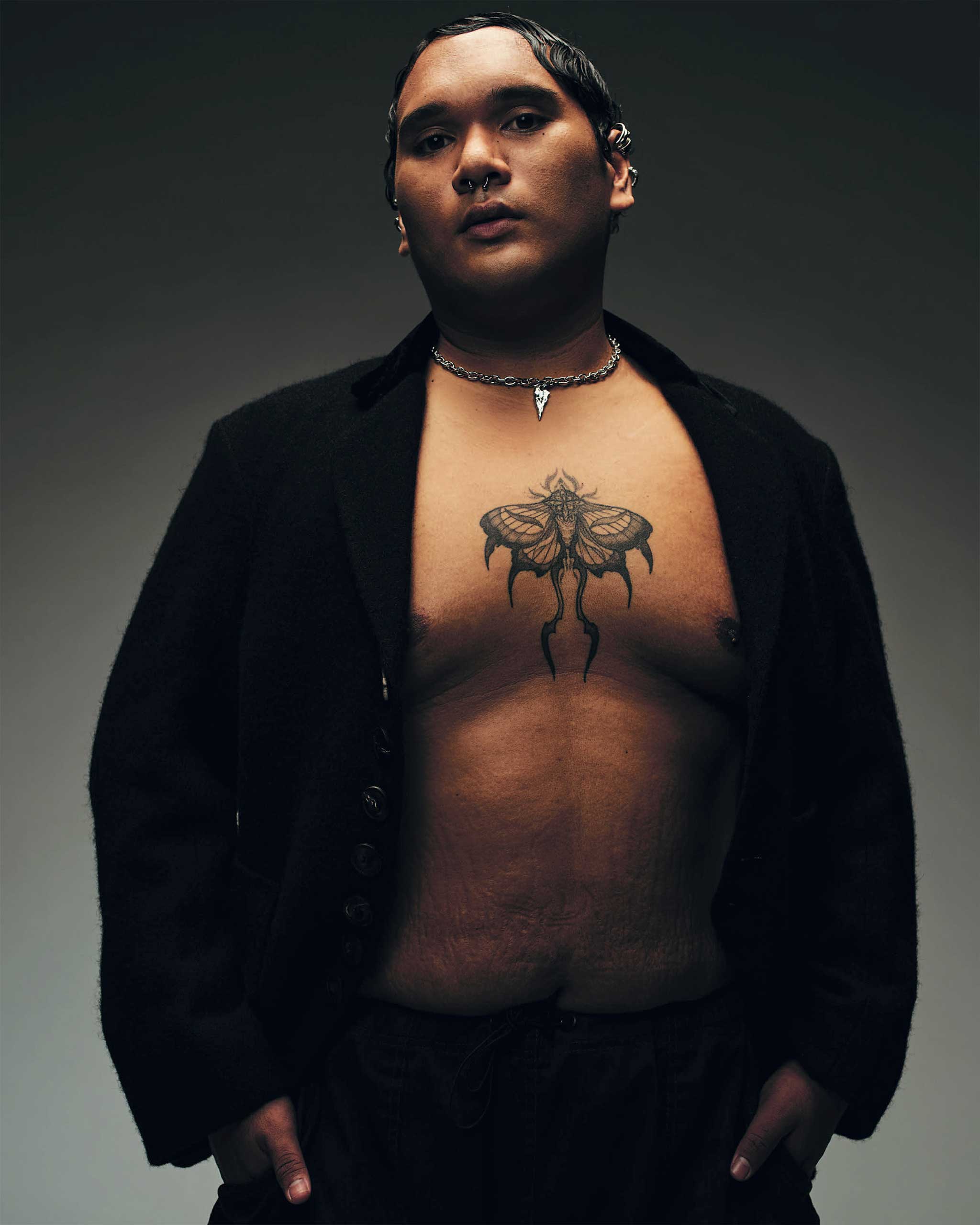Photographs by Zantz Han for the June 2024 Issue of Vogue Man Philippines.
What does body inclusivity for men look like in 2024? One individual speaks about plus-sized representation, identity and personal style.
The visibility of male plus-sized bodies seems to be relegated to the realm of the great ‘what ifs’ of fashion. And though the conversation has been kickstarted countless times—a quick Google search unearths a plethora of attempts—it has died down with a defeated shrug each time. The question still stands, though. Where are all the male plus-sized models?
While diversity has arguably been one of the industry’s biggest mandates, Vogue Business’ size inclusivity report for spring/summer 2024 revealed a stark reality: out of 9,584 looks spanning 230 shows across four cities, only 0.9 percent were plus-sized—a term classified as larger than a size US 14. Despite London’s recognition as one of the most diverse cities and the return of mainstay models such as Paloma Elsesser to fashion week last season, the shows demonstrated only a marginal improvement in their casting. However, the pressure for representation continues to mount, and brands aren’t keeping up—especially when it comes to male, male-presenting and non-binary individuals.
In Singapore, the narrative isn’t much different. Despite a burgeoning fashion scene posing its own limitations, inclusion hasn’t expanded beyond a set margin. Coupled with the regular programming featuring figures such as Henry Cavill, Chris Evans and the ideals of K-pop, the complex narratives of male desirability are ever-changing. The result? The slow erasure of anyone who falls into the category of ‘other’.

“Growing up in Singapore in the early 2000s, the concept of ideal masculinity was heavily centred around toughness and emotional restraint. It seemed that every man was expected to embody a stoic leader, show no vulnerability and keep emotions tightly under wraps. Additionally, there was an association between masculinity and sexual conquest,” recounts 25-year-old freelance artist, Hydir.
Streetcasted for this Vogue Singapore shoot, the former theatre major stands at a striking 180cm tall, with inky jet black hair and a charming smile. When asked if they have modelled before, they shrug and say: “Not professionally, at least.” As it stands, the number of signed male plus-sized models in Singapore is slim (as of last month, there was one), but it’s not for the lack of trying. Despite efforts, there simply isn’t a market for it, at least in fashion. That, coupled with the limited options of sizing across contemporary labels, has made stylistic self-expression a feat. “There’s a preconceived notion that plus-sized men lack fashion sense and don’t care about style. Growing up as a plus-sized individual often left a bitter taste when it came to clothing,” notes Hydir. “The frustration of not finding anything that fit or feeling unable to wear the same trendy clothes as my mates at school led to a messy relationship with my body image. It’s not that I lack interest in style; rather, it’s the limited access to the clothing I want to express myself with that has been the challenge.”
Now a marketing executive at a small arts company, the Nanyang Academy of Fine Arts graduate chuckles as they gingerly reminisce about their early experiences shopping for clothing. “I remember when I had my formal night at 11, and I had to shop for an outfit in the adult’s section as the kids’ sizes couldn’t fit me,” they recount.
“My current style is a compromise. In an ideal world where the size tag on clothing doesn’t matter, I think it would be quite different”
These days, an outfit for Hydir is all black, oversized and structured, finished with a pair of pointed Chelsea boots. They describe their style as bold simplicity with cultural influence, gravitating towards incorporating elements from their Indonesian and Pakistani heritage through jewellery and textile. “I love looser clothes; they allow for ease of movement when I walk around.” Layering accessories is big for them as well, with chunky jewellery such as bracelets and necklaces often being the statement of their ensembles. “My current style is somewhat of a compromise, influenced not only by my preferences but also by what’s available to me. In an ideal world where the size tag on clothing doesn’t matter, I think my style would be quite different.”
They share that there are still plenty of stigmas surrounding the topic of body image for men, despite the industry taking steps towards inclusivity. Hydir reckons that it stems from the conventional standards of male beauty, explaining: “Society has this predetermined idea of what’s attractive for men, and anything outside that gets brushed aside. It’s disheartening to see that plus-sized men are not as attractive as those who fit the traditional archetypes.”
Despite noting a lack of male plus-sized communities in Singapore and the lack of local representation, Hydir has also observed a shift in expression and creativity, with more people being clued in to the harmful attitudes associated with traditional gender norms. Along their journey of navigating body image and self-esteem, they’ve navigated their own safe spaces that they’ve been able to turn to as resources. “My friends are my rock. They’re this amazing bunch of creative souls, dancers, actors, painters, musicians, you name it. Being around them feels like home. They’ve played a huge part in making me feel comfortable in my skin, and they’re the first ones who made me feel beautiful. I think it’s because creatives have this special way of seeing the world. They’re open-minded and accepting of all kinds of expressions, including different body types. Being around them, I’ve learnt to appreciate my uniqueness. It’s like being celebrated for who I am, and that’s something really special.”
Photographs by ZANTZ HA. Styling by BRYAN HO & NICHOLAS SEE. Makeup: Wee Ming using Nars. Hair: Marc Teng using Goldwell Professional. Producer: David Bay. Photographer’s Assistant: Sin Yean Yam.

